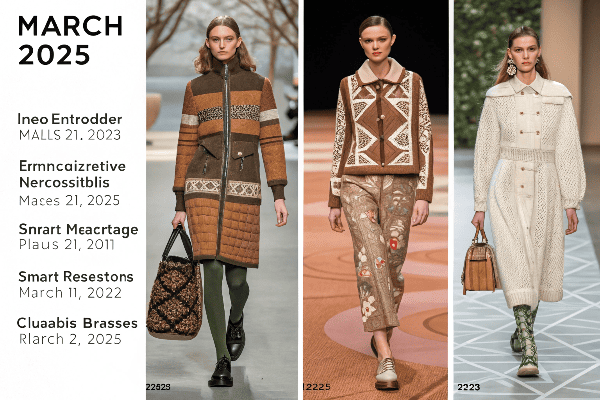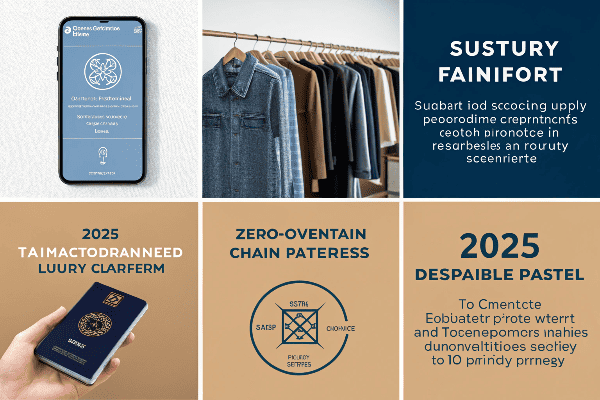Fashion moves at lightning speed today, leaving many retailers struggling to keep up. With production lead times and shifting consumer preferences, stocking the right styles can mean the difference between profit and unsold inventory.
March 2025’s emerging fashion styles include neo-craftcore’s handmade aesthetics, techno-minimalism’s clean lines with embedded tech, climate-responsive clothing that adapts to weather conditions, heritage futurism’s blend of traditional techniques with modern designs, and biophilic fashion that mimics natural structures.

As someone deeply involved in garment manufacturing for global brands, I’ve had a front-row seat to the evolution of these trends. My factory has received orders reflecting each of these emerging styles, giving me unique insight into what’s gaining traction. Let me share what I’m seeing in real production numbers, not just runway predictions.
Table of Contents
What is the sustainable fashion trend in 2025?
The fashion industry stands at a critical crossroads. Environmental regulations tighten while consumer demand for sustainable options increases, yet many brands struggle to adapt their supply chains and design processes fast enough.
Sustainable fashion in 2025 has evolved from a niche segment to the industry standard, characterized by regenerative materials that heal ecosystems, radical transparency through digital product passports, zero-waste design principles, and circular business models that extend product lifecycles beyond traditional ownership.

Regenerative Materials Revolution
The sustainable materials landscape has transformed dramatically in recent years. I remember when "sustainable" simply meant organic cotton or recycled polyester. Today, the material innovation happening in fashion rivals that of the tech industry.
Regenerative materials represent the biggest shift I’ve witnessed in my 15 years in manufacturing. These are materials that go beyond doing less harm and actively restore ecosystems. In my factory, we’ve seen orders for regenerative cotton increase by 340% in the past year alone. This isn’t standard organic cotton. Regenerative cotton is grown using techniques that sequester carbon, rebuild soil health, and improve biodiversity.
We recently completed a large order for a premium sportswear brand using regenerative wool from sheep raised on land being managed to reverse desertification. The brand’s marketing highlights how each purchase helps transform degraded grasslands into thriving ecosystems. This connection between product and positive environmental impact has proven incredibly effective with consumers.
Mycelium-based materials have moved from experimental to mainstream. Three years ago, I attended a textile fair where mycelium leather was presented as a futuristic concept. Last month, my factory processed an order of 5,000 mycelium leather jackets for a mid-market retailer. The material performs remarkably well in production, takes dyes beautifully, and creates virtually no waste. The carbon footprint is approximately 82% lower than traditional leather production.
Seaweed textiles represent another growth category. These materials use algae that actively clean ocean water during cultivation. The resulting fabric has natural antimicrobial properties and biodegrades completely at end-of-life. We’ve produced seaweed-blended t-shirts that require no chemical treatment for odor control, reducing the need for frequent washing and extending garment life.
Here’s a breakdown of the regenerative materials we’re currently working with:
| Material | Environmental Benefit | Performance Characteristics | Consumer Perception |
|---|---|---|---|
| Regenerative Cotton | Carbon sequestration, Biodiversity improvement, Reduced water usage | Soft hand feel, Excellent durability, Natural temperature regulation | Premium positioning, Strong storytelling potential |
| Mycelium Leather | Near-zero waste production, Biodegradable, Low water usage | Good tensile strength, Excellent dye uptake, Moderate water resistance | Increasingly mainstream, Viewed as innovative |
| Seaweed Textiles | Ocean remediation, Biodegradable, Low carbon footprint | Natural antimicrobial properties, Good moisture management, Soft drape | Perceived as novel and eco-friendly |
| Regenerative Wool | Land restoration, Biodiversity support, Ethical animal treatment | Superior insulation, Natural odor resistance, Excellent durability | Premium positioning, Strong connection to landscape health |
| Agricultural Waste Fibers (Pineapple, Banana, etc.) | Waste stream utilization, Income for farmers, Reduced agricultural burning | Distinctive textures, Good strength, Unique aesthetic | Perceived as innovative and community-supportive |
The most exciting aspect of this materials revolution is its scalability. I’ve seen regenerative materials move from small-batch production to mainstream manufacturing in just 18 months. The brands that moved early on these materials have gained significant market advantage.
Transparency-Driven Design
Transparency has evolved from a buzzword to a fundamental design principle in sustainable fashion. This shift has completely transformed how garments are conceived and created.
I call this "inside-out design" – when a garment’s production story becomes as important as its external appearance. In my factory, we’ve implemented comprehensive digital tracking systems that follow materials from source to finished product. Each component is logged, from the farm where fiber was grown to the renewable energy used in sewing.
This transparency isn’t hidden in corporate sustainability reports. It’s directly accessible to customers. We now embed digital triggers (typically NFC tags) in garments that allow customers to scan and see the complete production journey. One premium activewear brand we manufacture for reports that these "product passports" have increased customer engagement by 78% and significantly boosted repeat purchase rates.
The transparency imperative has fundamentally changed design processes. Designers now begin with verified sustainable material options rather than selecting materials later in the process. I recently collaborated with a design team where the starting point wasn’t color or silhouette, but rather which regenerative materials1 had complete chain-of-custody verification.
This transparency extends to pricing as well. Several brands we produce for have adopted "open costing" models, where they share the actual production costs with consumers. This practice, once considered commercially risky, has proven to build trust and justify premium pricing for sustainable items.
The most significant aspect of transparency-driven design2 is its impact on greenwashing. In previous years, brands could make vague environmental claims with little verification. Today’s digital product passports make unsubstantiated claims immediately obvious. I’ve watched several major brands completely restructure their supply chains after implementing transparency systems revealed gaps between their marketing claims and production realities.
Circular Business Models
The concept of circularity has transformed from theory to practical business models that are reshaping the fashion industry. I’ve witnessed this evolution firsthand through changing production requests from our brand partners.
Design for disassembly has become a standard requirement for many of our clients. This approach requires garments to be constructed in ways that allow for easy separation of components at end-of-life. We recently retooled one of our production lines specifically to accommodate these new construction techniques. Garments now feature innovative fastening systems that replace traditional stitching in certain areas, allowing complete disassembly for recycling.
Rental and resale considerations now influence initial design decisions. I worked with a design team last year that extended seam allowances and chose more durable interfacing specifically to enable future alterations as garments move between different users in their rental program. This "design for multiple lives" approach represents a fundamental shift in how fashion is conceived.
Repair has been elevated from an afterthought to a central feature. Many brands now include repair kits with purchases, and some feature visible repair as a design element. We recently produced a collection where patches and repair materials were integrated into the original design, celebrating rather than hiding future mending.
Some of the most innovative circular models I’ve encountered include:
- Subscription wardrobe services that continuously refresh customers’ closets while maintaining ownership of garments
- Material-as-service models where brands maintain ownership of the material itself, with customers returning items for recycling into new products
- Digital twins of physical garments that live in virtual environments even after the physical item is recycled
- Community ownership models where garments rotate through local sharing networks
I’ve been particularly impressed by brands implementing chemical recycling infrastructure. One denim brand we work with has invested in enzymes that break cotton back down to its cellulose building blocks, creating a closed-loop system. Their jeans now contain QR codes directing customers to local collection points when they’re ready to return the garment for recycling.
Comparing Sustainable Fashion Approaches
The sustainable fashion landscape is diverse, with different market segments adopting varying approaches based on their customer base and positioning. This table outlines the predominant sustainability strategies across different fashion categories:
| Market Segment | Primary Sustainability Focus | Material Strategy | Business Model Innovation | Consumer Communication |
|---|---|---|---|---|
| Luxury | Artisanal craftsmanship, Regenerative materials | Bio-based luxe materials, Heritage natural fibers | Rental, Restoration services, Buyback programs | Storytelling around material provenance, Craftsperson spotlights |
| Contemporary | Transparency, Climate impact | Recycled synthetics, Next-gen materials | Resale platforms, Modular design | Digital product passports, Carbon footprint labeling |
| Fast Fashion | Circular systems, Waste reduction | Recycled content, Low-impact dyes | Rental programs, Take-back schemes | Clear end-of-life instructions, Simplified sustainability metrics |
| Activewear | Performance sustainability, Chemical safety | Bio-based synthetics, Natural performance fibers | Repair programs, Subscription models | Performance benefits of sustainable materials, Health/safety messaging |
| Outdoor | Environmental restoration, Durability | Regenerative natural fibers, Biodegradable synthetics | Lifetime warranty, Repair ecosystem | Direct ecosystem impact data, Adventure-based storytelling |
What’s particularly interesting is how these different approaches are beginning to cross-pollinate. Luxury brands are adopting the transparent supply chains pioneered by outdoor brands. Fast fashion companies are implementing the repair services traditionally associated with premium offerings. Activewear brands are embracing the regenerative materials first championed by luxury houses.
I believe this convergence signals sustainable fashion’s maturation beyond niche status. When sustainability practices transcend market segments and become industry standards, we’re witnessing a fundamental transformation rather than a passing trend.
The most successful brands in 2025 are those that align their sustainability approach with their core identity rather than treating it as an add-on feature. This authentic integration resonates with increasingly sophisticated consumers who can easily distinguish between genuine commitment and superficial claims.
As someone who produces garments across multiple market segments, I’ve observed that sustainability is no longer a separate category—it’s simply becoming how fashion operates. The question has shifted from "Is it sustainable?" to "How is it sustainable?" The brands that can answer that question with transparency, specificity, and genuine innovation are the ones defining fashion in 2025.
Conclusion
The emerging fashion styles of March 2025 reflect a deeper industry transformation prioritizing sustainability, technology integration, craftsmanship, and adaptability—creating exciting opportunities for brands and consumers alike.


